
Rhododendron & Azalea News
Harold Greer
May 21, 1945 - August 10, 2021
edited by Steve Henning
Valley Forge Chapter ARS
Harold Greer and Greer Gardens
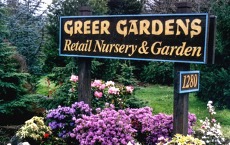 The Greer nursery on Goodpasture Island Road in Eugene Oregon.
The Greer nursery on Goodpasture Island Road in Eugene Oregon.
|
According to Harold, he began to hybridize rhododendrons by about age 7. He is reputed to have said, "I chose two rhododendrons that bloomed first in the spring, a lepidote and an elepidote. Of course, the attempted cross was a colossal failure, the two plants were incompatible." That did not dissuade Harold from further exploration. Harold Greer's father, Edgar Greer, started Greer Gardens in the 1950s. He intended it to be a hobby after he retired from the insurance busines.
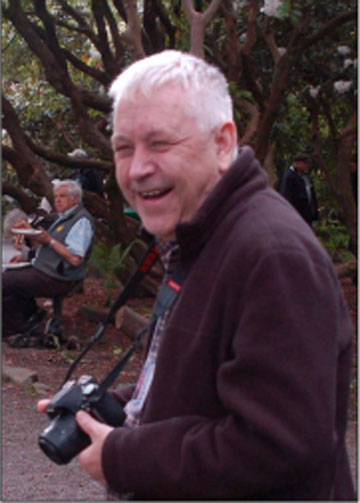 Harold Greer photographing rhododendrons at an ARS convention where he was a speaker.
Harold Greer photographing rhododendrons at an ARS convention where he was a speaker.
|
Harold Greer started his adventures with rhododendrons at the tender age of 6, after his father moved from Colorado to Oregon in 1952 after retiring from the insurance busines. Discovering a climate suitable for growing beautiful plants, Harold's father began collecting roses, fuchsias, chrysanthemums and an obscure plant he had never seen or even heard of, the rhododendron. In a few years, a lot adjacent to this home was soon filled with rhododendrons. So, seeking more land, the family moved to the 3-acre property in Eugene on Goodpasture Island Road where father and son, Harold, pursued their rhododendron interests including hybridizing.
By age 15, Harold produced the pink flowered Rcv. 'Trude Webster' which, in 1971, received the American Rhododendron Society's first Superior Plant Award. Harold studied horticulture and landscape architecture at the University of Oregon and then launched Greer Gardens in 1972 after the death of his father. The nursery -- an outgrowth of that fortuitous move to Oregon -- became an international seller of rare and unusual plants. Harold and Nancy were married in 1976.
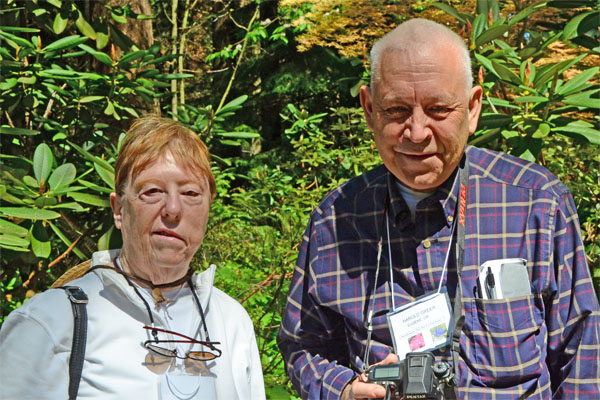 Harold & Nancy Greer at a rhododendron conference.
Harold & Nancy Greer at a rhododendron conference.
|
Harold and Nancy Greer bought an additional 11 acres in 1985. The nursery was well known for its wide variety of plants, including rare species and hybrids. Harold had extensive knowledge about botany, particularly rhododendrons. He experimented with crossing varieties and creating many rhododendron hybrids, ultimately registering more than one hundred varieties of rhododendrons with the American Rhododendron Society and publishing three books about rhododendrons. The popular Greer Gardens catalog featured 4,000 varieties of plants that could be shipped all over the world.
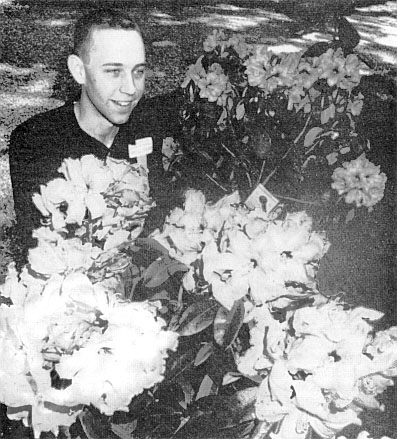 Harold Greer at the 1967 Eugene Chapter Show.
Harold Greer at the 1967 Eugene Chapter Show.
|
Business peaked in the mid-1990s, when they employed nearly 30 people. But they subsequently cut back to about 10 employees, as many of their orders had moved online. Greer Gardens was home to more than 1000 rhododendron plants along with hundreds of Japanese maples in addition to various other plants.
The Greer family had been involved in rhododendrons for more than 60 years. Greer Gardens started as a hobby of Harold Greer's father, Edgar, whose death in 1972 was the impetus for Harold to make a hobby into a business. Greer Gardens grew into an internationally known mail-order nursery, shipping plants worldwide.
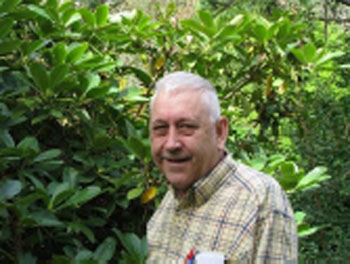 Harold Greer at Greer Gardens.
Harold Greer at Greer Gardens.
|
Greer was very active in the American Rhododendron Society. He served as Eugene Chapter President in 1978 and then became president of the ARS from 1987 to 1989. He was renowned as one of the world's foremost experts on Rhododendrons. In 1989, Harold Greer was the youngest person ever to receive an ARS Gold Medal and the youngest to serve as president of the Society. He was the organizing founder of the Western Regional Conferences some 41 years ago and was to co-chair the 2022 convention with Mike Stewart.
 Harold receiving the ARS Gold Medal in 1989.
Harold receiving the ARS Gold Medal in 1989.
|
He was recognized internationally for his thorough knowledge of rhododendron cultivars, his expertise in growing rhododendrons, for his books on the subject, for his plants, and for his service and dedication to the international rhododendron community. He was an accomplished photographer whose pictures have been published widely including on the cover of Smithsonian Magazine. The combination of his extensive knowledge and his warm and engaging style made him a popular speaker.
In 2015, the Greers retired and closed the nursery. They donated many plants from the nursery to the Overleaf Lodge & Spa on the Oregon coast in Yachats, OR, which the lodge used to create Greer's Garden on their property. The Overleaf's gardener designed the extensive garden with the donated plants, which included rosemary, boxwood, phormium, heather, Point Reyes ceanothus and hydrangeas. There is also a hand carved sign with the name "Greer's Garden" made from driftwood from the beach. The garden provides a colorful welcome to guests as they drive into the Overleaf, as well as honors a favorite guest and friend of the lodge.
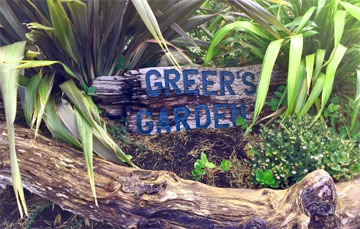 Greer's Garden at Overleaf Lodge & Spa in Yachats, Oregon - a tribute to Harold Greer.
Greer's Garden at Overleaf Lodge & Spa in Yachats, Oregon - a tribute to Harold Greer.
|
At the time when The Springs Living was looking to build a senior community in Eugene, Harold and Nancy Greer were at the crossroads of retiring from Greer Gardens Nursery. The timing was perfect for both parties and they decided to conceptualize a plan for what would become The Springs at Greer Gardens. With 14 acres to work with, they were able to honor the original nursery's rich heritage and provide a new home for Harold and Nancy as part of the development.
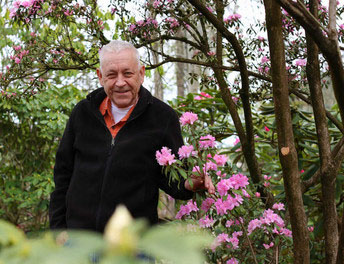 Harold Greer at The Springs at Greer Gardens which was built on former Greer Gardens site.
Harold Greer at The Springs at Greer Gardens which was built on former Greer Gardens site.
|
In 2015, Greer Gardens' site preparation began on the 14-acres to make way for a 216-unit senior and assisted living center. The Springs Living, a McMinnville-based developer of senior housing, had been working with the Greers for several years trying to build an independent, assisted living and memory care facility on their property, one of the largest undeveloped pieces of private land left in north Eugene. In 2016, the construction began, and, in 2017, residents began moving in.
The Greers were development partners with The Springs Living, and they still owned the land. The couple both had recently turned 70, Harold Greer said, and they had been wanting to step away from the business for a few years.
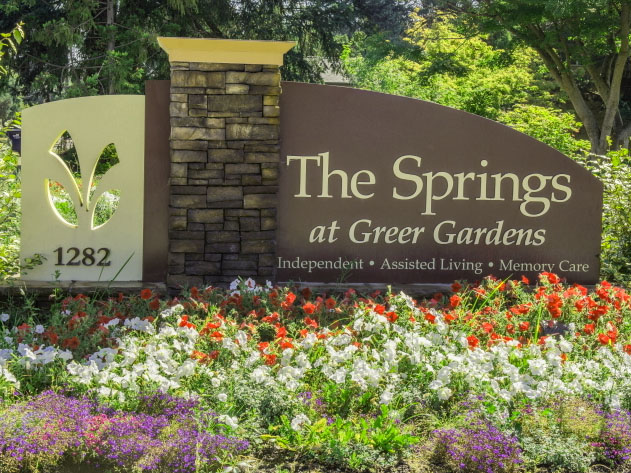 The Springs on Goodpasture Island Road in Eugene Oregon..
The Springs on Goodpasture Island Road in Eugene Oregon..
|
Letting The Springs Living build "is probably the best use of the property you could find," Greer said. "It's too valuable for what it has been used as, and the city would probably like some more tax (revenue) than what they're getting off it now."
The project wasn't exactly the end for Greer Gardens, however. The Springs Living included a single-family house on the western part of the property for the Greers to live in. Since retiring in 2015, Harold continued to grow plants for year-round color in a garden at the Greers' custom-built home on the same property as the former nursery. Dozens of rare, mature trees were dug up and stockpiled to be later transplanted back onto the site per the landscape design and at the direction of Anderson Associates. The project's first phase consisted of the main 3-story 190,000 square foot Independent and assisted living building, a single story 25,000 foot memory care building and 12 single story cottages. Phase two began construction in 2018 and included 18 one story cottages.
The Greer Gardens' Heritage continues in Eugene on Goodpasture Island Road on the site of the Greer Gardens nursery.
References:
-
Rhododendron Hybrids - A Guide To Their Origins, Homer E. Salley and Harold E. Greer, Timber Press, 1986.
-
Greer's Guidebook To Available Rhododendrons - species & hybrids, third edition, Harold Greer, Offshoot Publications, 1996.
-
The Pacific Coast Rhododendron Story - The Hybridizers, Collectors and Gardens, first edition, Sonja Nelson & the Portland ARS Chapter, Binfort & Mort Publishing, 2001.
-
The International Rhododendron Register and Checklist Second Edition 2004:
https://www.rhodogroup-rhs.org/publications/books/rhodo-register.
-
Greer Gardens to become retirement village; Neighborhood News, December 6, 2012:
https://j361neighborhoodnews.wordpress.com/2012/12/06/4930/
-
Nursery Uprooting; Register Guard, July 9, 2015:
https://www.registerguard.com/article/20150709/news/307099872
-
Greer's Garden at Overleaf Lodge & Spa:
https://www.overleaflodge.com/greers-garden/
-
The Springs at Greer Gardens built on former nursery site; Oregon Live, August 8, 2017:
https://www.oregonlive.com/sponsor-content/?prx_t=PvYCAlEwSATQ4PA&prx_ro=s&ntv_fr
-
Spring Planting for Year Around Color; Register Guard, April 20, 2018:
https://www.facebook.com/registerguard/posts/harold-greer-and-his-wife-nancy-ran-the-former-greer-gardens-nursery-for-50-year/10155338635367256/
-
Harold Greer by Steve McCormick; Niagara Chapter ARS newsletter, September 20, 2019:
http://www.rhodoniagara.org/archives/newsletter/2019-09-20.pdf
-
The Springs at Greer Gardens Photo Gallery:
https://www.thespringsliving.com/senior-living/or/eugene/goodpasture-island-rd/photo-gallery
-
Anderson Associates, Landscape Planner:
https://www.andersonassociates-la.net/assisted-living-housing
-
Bond Lane Park, Eugene, Oregon:
https://www.eugene-or.gov/Facilities/Facility/Details/38
-
ARS 2022 Spring International Convention Sponsors:
https://ars2022.org/sponsors/
-
Thanks to Don Hyatt for providing photos.
-
Thanks for Steve McCormick for posting this to YouTube. https://www.youtube.com/watch?v=cGfWxTUa1D4
Back to top of Page
Greer Gardens Today
 The Springs at Greer Gardens.
The Springs at Greer Gardens.
|
 The Green House at The Springs at Greer Gardens.
The Green House at The Springs at Greer Gardens.
|
 Tranquil setting among rhododendrons at The Springs at Greer Gardens.
Tranquil setting among rhododendrons at The Springs at Greer Gardens.
|
 Cottages at The Springs at Greer Gardens.
Cottages at The Springs at Greer Gardens.
|
 Rhododendrons in the landscape at The Springs at Greer Gardens.
Rhododendrons in the landscape at The Springs at Greer Gardens.
|
 Rhododendrons in the landscape at The Springs at Greer Gardens.
Rhododendrons in the landscape at The Springs at Greer Gardens.
|
 Rhododendrons in the landscape at The Springs at Greer Gardens.
Rhododendrons in the landscape at The Springs at Greer Gardens.
|
 Rhododendrons in the landscape at The Springs at Greer Gardens.
Rhododendrons in the landscape at The Springs at Greer Gardens.
|
 The landscape at The Springs at Greer Gardens.
The landscape at The Springs at Greer Gardens.
|
 Bond Lane City Park adjoining The Springs at Greer Gardens.
Bond Lane City Park adjoining The Springs at Greer Gardens.
|

Harold Greer's Rcv. 'Trude Webster'.
|
 Harold Greer's Rcv. 'Very Berry'.
Harold Greer's Rcv. 'Very Berry'.
|
Back to top of Page
Harold Greer's Registered Hybrids
with photos & descriptions by Harold
- 'Albiflorum': semi-evergreen azalea, R. serpyllifolium selection, 1982.
- 'Apricot Sherbert': 'Comstock' x 'Dido', 1988.
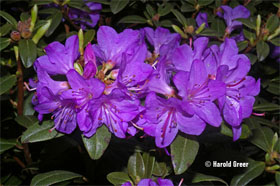 'Barto Alpine'
'Barto Alpine'
|
'Barto Alpine' — (Subsection Lapponica hybrid) 3 ft (.9 m), -10°F (-23°C), EM, 3/4. A very hardy and rugged plant that dances in the sun. Orchid-rose flowers open all along the stems of the densely branched plant. Sunshine warming the bark and leaves brings out a sweet, spicy scent of freshly ground nutmeg. Its dense upright growth habit is a form well-suited for planting as a short hedge or screen reaching, 1963.
- 'Barto Ivory': R. fortunei hybrid, 1961.
- 'Barto Lavender': unknown, 1961.
- 'Best Pink': evergreen azalea, R. kiusianum selection, 1984.
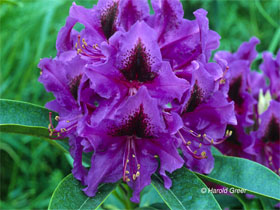 'Black Eye'
'Black Eye'
|
'Black Eye' — ('Anah Kruschke' x 'Purple Splendour') 5 ft (1.5 m), -10°F (-23°C), ML, 3-4/3-4. A sister seedling of 'Red Eye', this rugged plant stands sun well and blooms young. The deep red-purple flowers have a distinct "black eye" on the upper lobe. A great plant, 1982.
 'Black Magic'
'Black Magic'
|
'Black Magic' — ('Jean Marie de Montague' x 'Leo') 4 ft (1.2 m), 5°F (-15°C), ML, 4/4. Black-red flowers cover this plant in the late spring. They are exceptionally dark and show off their beauty best if planted in a location where the setting sun will shine through the flowers, causing them to glow magically. The medium foliage is matte forest green and covers the plant well, 1982.
 'Blue Lagoon'
'Blue Lagoon'
|
'Blue Lagoon' — ('Purple Splendour' x 'A. Bedford') 5 ft (1.5 m), -10°F (-23°C), ML, 3/4. A hybrid with an interesting background. Years ago we made this cross and distributed a plant to Galen Baxter in Florence, Oregon. Unfortunately we lost our original plant. Galen always enjoyed the rhododendron and gave some cuttings to Willard Thompson who propagated it and now has made it available to us again! It is out of the same cross that resulted in 'Plum Beautiful'. Mystical, smoky blue-purple flowers have a large and prominent deep purple eye. Showy! The recurved, deep forest green foliage adds an air of mystery to the 'Blue Lagoon,' 1992.
 'Brilliant'
'Brilliant'
|
'Brilliant' — ('Elizabeth' x Ledum columbianum) 2 ft (0.6 m), 0°F (-18°C), M, 3/3. This plant has small, bright red, funnel shaped flowers that are held above smooth, green leaves. After flowering, it has bronzy-red new growth. The open growth habit does make an enjoyable plant. It is said to be tolerant of both heat and lime but will be happiest if given some shade, 1962.
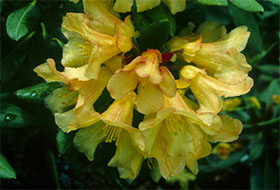 'Buttermint'
'Buttermint'
|
'Buttermint' — ('Unique' x ['Fabia' x R. dichroanthum ssp. apodectum]) 3 ft (.9 m), -5°F (-21°C), M, 4/3-4. Thick leathery leaves are pleasing in appearance and extremely dense on this compact plant. Plump flower buds mature early in the season, giving the appearance that the plant eagerly awaits its bloom time! Good sized, buttermint yellow flowers, 1979.
- 'Cheyenne': Jalisco group x Loderi group, 1963.
- 'Colleen': 'Purple Splendour' x 'A Bedford', 1971.
- 'Comstock': Jalisco group x Jasper group, 1979.
- 'Coral Velvet': R. degronianum ssp. yakushimanum x unknown, 1979.
- 'Cream Glory': 'Comstock' x 'Cheyenne', 1980.
- 'Eugene': 'Unique' x 'Jean Marie de Montague', 1971.
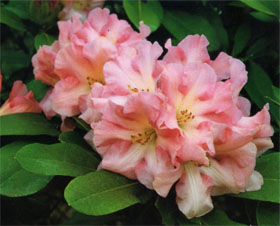 'Everything Nice'
'Everything Nice'
|
'Everything Nice' — ('Comstock' x 'Unique') 4 ft (1.2 m), 5°F (-15°C), E-EM, 4/4/3-4. Delightful clear pink flowers are rayed lighter pink, lending a glowing radiance. The flower has a calyx which rolls back its lobes as they age, resulting in a star shaped appearance in the center of the truss. The foliage is medium sized, an attractive matte green on a compact good looking plant. Unfortunately, it is neither extremely sun tolerant nor cold hardy, 1989.
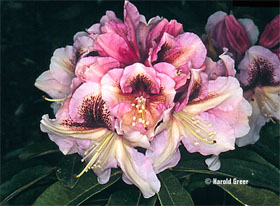 'Extraordinaire'
'Extraordinaire'
|
'Extraordinaire' — ('Gold Medal' x 'Olin O. Dobbs') 5 ft (1.5 m), -5°F (-21°C), M, -/-. An unusual hybrid. Rose pink buds open to flowers with pink-edged petals. A huge dark garnet red flare graces the upper petals, and the lower petals have a soft yellow center. Little by little, the whole flower becomes a creamy pink, causing the dark textured flare to stand out even more. Many large 5" individual flowers make large trusses. The foliage is a matte fir green. An interesting cross between a yellow and a purple, 1994.
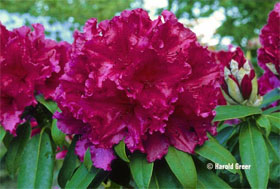 'Firewine'
'Firewine'
|
'Firewine' — ('Fire Bird' x 'Purple Splendour') 4 ft (1.2 m), 0°F (-18°C), ML, 4-5/3. Here is an unusual color for a rhododendron, hot wine-red purple and really bright! Each individual flower is ruffled and frilled in a most attractive manner. Boy, what beautiful trusses! It buds heavily and sports narrow, grass green leaves, 1979.
- 'Fort Langley': R. griersonianum hybrid, 1983.
- 'Fragrans Affinity': azaleodendron, 1996.
- 'Gipsy Queen': Bow Bells group x 'Barclayi Robert Fox', 1976.
- 'Girard's Remarkable Pink': R. degronianum ssp. yakushimanum x 'Girard Ruffled Red', 1996.
- 'Gold Medal': 'Cream Glory' x 'Seattle Gold', 1988.
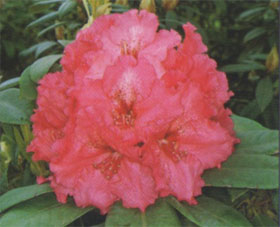 'Grand Slam'
'Grand Slam'
|
'Grand Slam' — ('Trude Webster' x 'Lydia') 6 ft (1.8 m), -5°F (-21°C), ML, 4-5/3-4. Giant trusses of fluorescent pink fill this plant with beauty. The trusses are often 1' tall and are a perfect cone shape; the ideal rhododendron truss. The leaves are large and glossy green, with sturdy stems that are on the same scale as the gigantic flowers. They are strong enough and big enough to support both the heavy flowers and foliage. This plant is vigorous and tidy when grown properly, 1982.
- 'Great Scott': 'Mrs J G Millais' x 'Cheyenne', 1979.
- 'Greeley'': 'Fawn' X R. eliottii x 'Umpqua Chief', 1961.
- 'Greer's Cream Delight': 'Barto Ivory' x 'Barto Lavender', 1988.
- 'Greer's Starbright': R. degronianum ssp. yakushimanum x 'Lady Bligh', 1988.
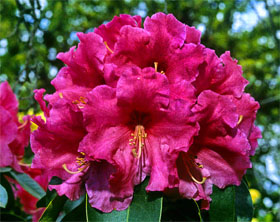 'Hallelujah'
'Hallelujah'
|
'Hallelujah' — ('Jean Marie de Montague' x 'Kimberly') 4 ft (1.2 m), -15°F (-26°C), M, 5/5. Of all rhododendrons introduced in recent years, this is one of the best. For foliage and plant, few rhododendrons come near its beauty. The leaves are deep woodland green, extremely heavy textured and have an attractive, downward curving form. The flowers are elegant rose-red in a large, tight truss. It is probably a tetraploid, meaning it has extra chromosomes which give extra substance to the leaves, stems and flowers. It's an adaptable rhododendron you will admire every time you see it but never more than when it is in flower, 1976.
- 'Harnden's White': Albatros group x Hawk group, 1979.
- 'Hazel': R. bureavii x unknown, 1979.
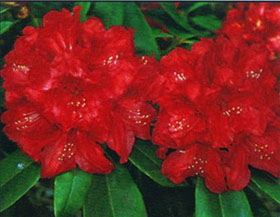 'Heat Wave'
'Heat Wave'
|
'Heat Wave' — ('Jean Marie de Montague' x 'Leo') 5 ft (1.5 m), -5°F (-21°C), ML, 4/3-4. Large, upright trusses of deep blood-red, composed of many flowers, cover this beautiful plant. The medium sized, dark forest green leaves make a delightful contrast with the exceptional red flowers. Growth habit is good, and the plant has stems strong enough to support its large trusses, 1982.
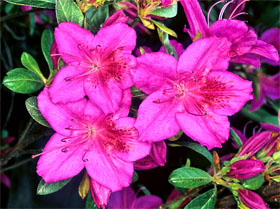 'Helen'
'Helen'
|
'Helen': evergreen az — ('Sekidera' seedling x 'Purple King') [Late, -5°F (-21°C), Tall] Few azaleas show purple tones, and this new one features large, deep purple flowers. Yew green foliage adds the right touch on this medium to large shrub, reaching 8' or more, 1983.
- 'High Fashion': deciduous az.; Knap Hill, 1976.
- 'Hiroshima': evergreen az, 1976.
- 'Hot Stuff': Carmen group x Leo group, 1982.
- 'Imperial': 'Purple Splendour' x 'A Bedford', 1983.
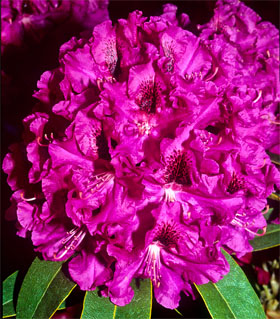
'Irresistible Impulse'
|
'Irresistible Impulse' — ('Mars' x 'Purple Splendour') 5 ft (1.5 m), -15°F (-26°C), ML, 4/3-4. Large trusses of deep red-purple completely cover this attractive plant. Each flower has a large, deep purple blotch on the upper lobe. It flowers very young, often on a one year old plant. Deep green leaves have a leathery texture, 1983.
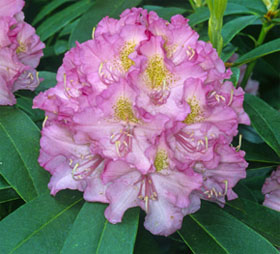 'Jackie Ann'
'Jackie Ann'
|
'Jackie Ann' — (R. macrophyllum hybrid) 5 ft (1.5 m), -10°F (-23°C), ML, 4/3. A soft pink bloom with a yellow eye on medium-green foliage. This introduction, with the "eye catching" eye, is a refreshing addition to the garden. The tight truss is one of those trophy winning shapes that makes everyone ask, "Where did you get that one?" 1983.
- 'Jack's Picotee': evergreen az.; unknown, 1983.
- 'Janielle': unknown yellow x 'Marcia', 1961.
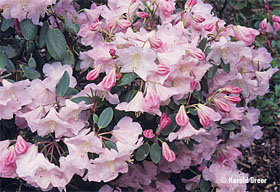 'Kimberly'
'Kimberly'
|
'Kimberly' — (R. williamsianum x R. fortunei ssp. fortunei) 3 ft (.9 m), -10°F (-23°C), EM, 3-4/4. A very beautiful, heavy flowering, pastel-pink plant. The slightly fragrant flowers appear in such profusion that all the foliage is covered. A sight to behold! The foliage is moss green with bright purple bud scales which make the plant attractive all winter long. A well behaved hybrid, you will want to plant 'Kimberly' in a very prominent location where you can view it all year, 1963.
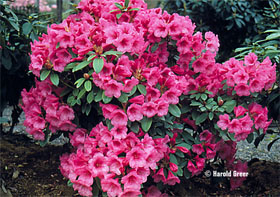 'Kimbeth'
'Kimbeth'
|
'Kimbeth' — ('Kimberly' x 'Elizabeth') 3 ft (.9 m), -5°F (-21°C), EM, 4/4-5. A perfect semidwarf for landscaping. Rouge-pink flower buds bring merry color through the winter. Rose colored flowers appear on every stem of the plant, making a solid mass of color, 1979.
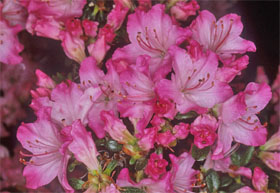 'R. kiusianum 'Komo Kulshan''
'R. kiusianum 'Komo Kulshan''
|
R. kiusianum 'Komo Kulshan' — 2 ft (.6 m), -10°F (-23°C), M-ML, 5/5/4. Here is an American selection that is one of the best seen. It is clear rose pink on the tips and a light pastel pink in the center. What a delightful two-toned appearance! Selected by Time Life Books as one of the best dwarf azaleas, 1978.
- 'Kyushu': R. heptamerum selection, 1983.
- 'Lake Baikal': R. daruicum selection, 1984.
- 'Larsen': R. bureavii selection, 1984.
- 'Lightly Lavender': R. degronianum ssp. yakushimanum x 'Purple Splendour', 1988.
- 'Lodbrit': Loderi group x 'Britannia', 1988.
- 'Lois': R. pemakoense x R. racemosum, 1979.
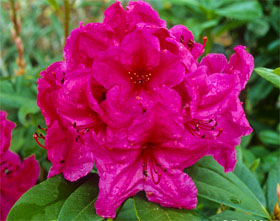 'Lydia'
'Lydia'
|
'Lydia' — ('Antoon van Welie' x 'Day Dream') 6 ft (1.8 m), 0°F (-18°C), ML, 4/3-4. Waxy fluorescent pink. This is the brightest color you will see in a flower. Its brilliance shines out from across the garden. A most unusual color. A vigorous grower, it buds heavily and boasts glossy green foliage. An exceptional rhododendron, 1963.
- 'Macranthum Dwarf': evergreen az.; R. indicum selection, 1978.
- 'Marvellous': 'Countess of Derby' x unknown, 1962.

'Misty Moonlight'
|
'Misty Moonlight' — ('Kimberly' selfed) 4 ft (1.2 m), -5°F (-21°C), EM, 3-4/4. Here is a joyous orchid-pink, and it's fragrant! It has glossy, deep green leaves with contrasting red leaf stems, which cover a mounding plant habit, 1982.
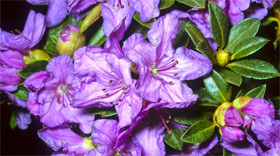 'Mother Greer'
'Mother Greer'
|
'Mother Greer' — (R. hippophaeoides x Subsection Triflora) 18", -15°F (-26°C), M-ML, 3-4/4. We are very proud of this hybrid. It is a cross made by my mother some years ago, and it is named in her honor. The flowers remind you of R. hippophaeoides in shape, although they are much larger. Rich lavender flowers appear after all of the other blues are done. A very nice feature. Don't ask me how it could happen from these two parents, but the foliage and plant remind me of R. hippophaeoides, only much more compact. It does not go through the distressed appearance during winter which is often typical of R. hippophaeoides, 1978.
- 'Oki Island': deciduous az.; R. japonicum selection, 1983.
 'Olin O. Dobbs'
'Olin O. Dobbs'
|
'Olin O. Dobbs' — ('Mars' x 'Purple Splendour') 4 ft (1.2 m), -15°F (-26°C), M, 5/3. A variety that is a very deep, waxy red-purple. The flowers have tremendous substance and are so waxy that it is hard to believe they are real. Buds young. Much like 'Mars' in growth and plant habit. The trusses are large and compact in a perfect conical shape, 1979.
- 'Otomeno': evergreen az.; R. kiusianum x Satsuki selection, 1983.
- 'Overstreet': R. degronianum ssp. yakushimanum selection, 1984.
- 'Peach Surprise': (Jaliso group x Loderi group) x R. decorum X 'Dot' x 'Fawn', 1984.
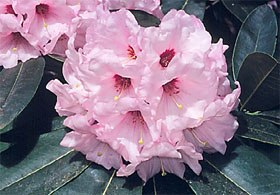 'Perfectly Pink'
'Perfectly Pink'
|
'Perfectly Pink' — ('Babylon' x unknown) 6 ft (1.8 m), -5°F (-21°C), E, 5/5. Flowers of soft, perfect pink are enhanced by a ring of deep maroon red in the center. The edges of the large flowers roll back, forming a giant truss which is so lovely! The glossy leaves are up to 10" long making a ring of excellent foliage under the trusses. Very heavy stems are strong enough to support the weighty trusses, 1988.
- 'Pink Fluff': R. racemosum x R. davidsonianum, 1979.
- 'Pinky Pearce': evergreen az.; unknown, 1983.
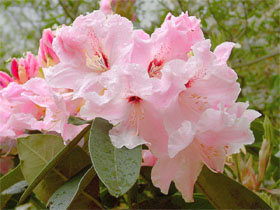 'Platinum Pearl'
'Platinum Pearl'
|
'Platinum Pearl' — ('Trude Webster' x R. fortunei ssp. discolor) 6 ft (1.8 m), -10°F (-23°C), ML, 4/4. Tests performed in California and Georgia, showed good tolerance to heat as well as cold and adverse cultivation. This strong grower forms huge flower buds early in the fall. Each pearl pink flower is made more showy by a dark rose blotch at the base. The foliage is large, leek green and on sturdy stems that are well able to hold up the huge trusses. Best grown in light shade where the foliage develops to near perfection, 1983. (Photo by S. Henning)
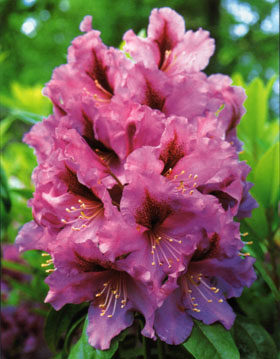
'Plum Beautiful'
|
'Plum Beautiful' — ('Purple Splendour' x 'A. Bedford') 5 ft (1.5 m), -10°F (-23°C), ML, 4/3. Here is a sturdy growing plant. The leathery green leaves have a slight downward twist making a valued foliage plant. Those huge dark purple trusses have a showy black marking on the upper petal. This really is a sensational hybrid! 1983.
- 'Popeye': Lodauric group x 'Purple Splendour', 1988.
- 'Purple Elegance': R. ponticum hybrid, 1978.
- 'Razzle Dazzle': 'Mrs J G Millais' x 'Cheyenne', 1982.
 'Red Delicious'
'Red Delicious'
|
'Red Delicious' — ('Jean de Marie Montague' x 'Leo') 5 ft (1.5 m), -5°F (-21°C), ML-L, 4/4. Bright, shining, fire red flowers! It's vigorous, easy to grow, and flowers fairly late in the season, so it will extend the color in your garden. A rounded plant, it is covered with deep fir green leaves making it a special plant all year. Ooh, is it showy! 1989.
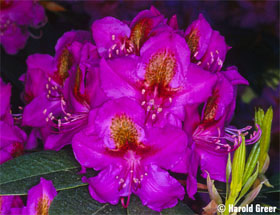 'Red Eye'
'Red Eye'
|
'Red Eye' — ('Anah Kruschke' x 'Purple Splendour') 5 ft (1.5 m), -10°F (-23°C), ML, 4/4. Here's a plant that stands sun, buds young, branches readily and does not mind heavy cutting for propagation! It's the kind of plant you can depend on year after year. The flowers are deep red-purple with a most interesting eye. When the flower first opens, the eye is green gold and little by little it becomes red. It is an interesting contrast with the purple! While some may think 'Red Eye' is a misnomer because the "eye" isn't always red, it is the name that was attached and has stayed with the plant. The foliage is shiny, medium sized, and dense. Stands heat well, 1980.
- 'Robbins': R. bureavii selection, 1984.
- 'Rouge Aureum': R. aureum selection, 1973.
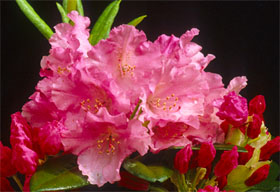 'Senorita Chere'
'Senorita Chere'
|
'Senorita Chere' — (R. degronianum ssp. yakushimanum x 'Mars') 4 ft (1.2 m), -15°F (-26°C), M, 4/4-5. Buds of delicious red are the beginning of this beautiful flower. It opens to rose, then lightens to a luscious light rose. Tight trusses with an exceptional number of flowers cover this plant in profusion. Compact growth habit, with heavy leaf cover makes an exceptionally beautiful plant year around. Hardiness is an added bonus! 1988.
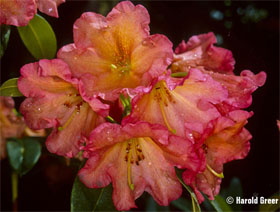 'September Song'
'September Song'
|
'September Song' — ('Dido' x 'Fawn') 4 ft (1.2 m), 0°F (-18°C), M, 4-5/4. This fantastic rhododendron, which was hybridized by the late Dr. Carl Phetteplace and grown by us, is something we think you will enjoy. It has warm orange flowers appearing as crowns on top of a plant with great foliage, and good habit. There are always loads of buds, and it buds young. We realize we're prejudiced, but this is a good one! 1998.
- R. davidsonianum 'Serenade' — This is a smaller R. davidsonianum form with rounder leaves, and a good pink color. 1982.
- 'Shoi Pink': evergreen az.; R. kiusianum selection, 1976.
- 'Shooting Star': lepidote; R. hippophaeoides x R. racemosum, 1989.
- 'Silver Frost': R. kyomaruense selection, 2010.
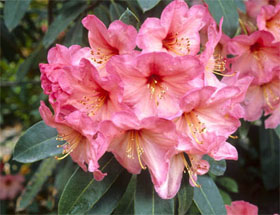 'Springfield'
'Springfield'
|
'Springfield' — ('Umpqua Chief' x 'Fawn') 5 ft (1.5 m), 5°F (-15°C), L, 4/3. For those of you who go bananas over those subtle orange shades, this one is for you. The salmon-orange color is not duplicated by any other rhododendron. It was featured in the winter 1979 issue of the American Rhododendron Society bulletin. The color is great, but it is really hard to capture its beauty on the printed page. Long, narrow fir green leaves clothe this upright plant. Worth reserving a place for in your garden, 1979.
- 'Spring Fling': lepidote; Lapponica selection x R. russatum, 1982.
- 'Stadtman': deciduous az.; Knap Hill, 1989.
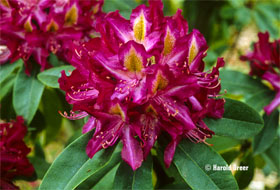 'Starburst'
'Starburst'
|
'Starburst' — ('Moser's Maroon' x 'Purple Splendour') 6 ft (1.8 m), 5°F (-15°C), L, 4/2-3. Bright red purple flowers accented by a golden blotch on the upper petal make this a showy flower. Then to make it even more of a show stopper, the blotch and center of the flowers are surrounded in white. It's late flowering, extending your blooming season, and it has interesting wavy foliage. Sometimes mistakenly sold as 'Dark Star', 1982.
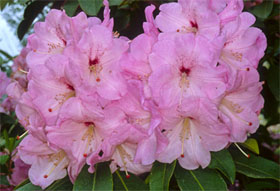 'Sugar Pink'
'Sugar Pink'
|
'Sugar Pink' — ('Trude Webster' x ['Fawn' x 'Queen of the May']) 6 ft (1.8 m), -5°F (-21°C), M, 4/4. We are pleased to offer this fine hybrid. The demand is so great that it has been difficult to have enough plants available. 'Sugar Pink' has about the tallest truss of any rhododendron (often over 1') and has foliage to match. The flower is tantalizing cotton candy pink. This hybrid has taken all the best traits of its parent 'Trude Webster'. The foliage is large, smooth and deep green. Wonderful! 1979.
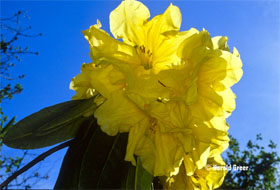 'Sunspray'
'Sunspray'
|
'Sunspray' — ('Alice Franklin' x 'Crest') 6 ft (1.8 m), -5°F (-21°C), M, 5/3-4. Imagine a rhododendron with flowers even more yellow and larger than those of 'Crest', with better foliage, better habit, and you have 'Sunspray'. The voluptuous trusses are such a pure and true yellow that they would put a lemon to shame. Lovely wide leaves 6" long fully clothe the branches, and they don't have the tendency to roll and droop in the winter the way 'Crest' does, 1979.
- 'Super Star': unknown, 1980.
- 'Tick-tock': 'Jean Marie de Montague' x R. williamsianum, 1972.
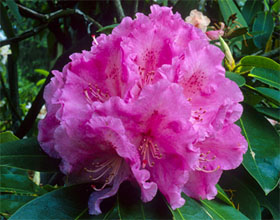 'Trude Webster'
'Trude Webster'
|
'Trude Webster' — ('Countess of Derby' x 'Countess of Derby') 5 ft (1.5 m), — 10°F, M, 5/4. We are justly proud of this variety which was the first plant to win the Superior Plant Award, the highest award possible for a rhododendron. To see a plant in full flower is such an awe inspiring sight that it will not soon be forgotten. The trusses are absolutely gigantic and the clear shade of pink is beyond description. The foliage is large, wide and slightly twisted making a perfect combination with the trusses. Plant habit is compact and upright. Excellence all around! 1961.
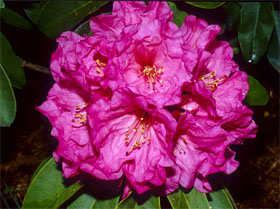 'Twilight Pink'
'Twilight Pink'
|
'Twilight Pink' — ([R. fortunei ssp. fortunei x 'Alice'] selfed x 'Comstock') 4 ft (1.2 m), -5°F (-21°C), M, 4/4. Named 'Twilight Pink' because the warm pink flower resembles the beautiful hues of pink and apricot at sunset. 'Twilight Pink' literally glows! The flower has a large calyx giving it a double appearance. The apple green leaves clothe the plant completely making it desirable year around. It grows as a compact, yet sturdy mound, 1983.
- 'Uki-funei': evergreen az.; unknown, 1987.

'Van'
|
'Van' — (R. griersonianum x 'Countess of Derby') 6 ft (1.8 m), -5°F (-21°C), ML, 3-4/4. Here is a sister to 'Anna Rose Whitney'. The cross, made by Van Veen and named 'Van' in his honor, is more compact and hardier with smaller, prominently veined foliage. The handsome, profusely blooming plant has deep pink flowers with a distinctive, darker center. A superior variety and one of the most attractive foliage plants that we have in the nursery, 1979.
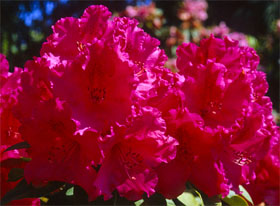 'Very Berry'
'Very Berry'
|
'Very Berry' — ('Trude Webster' x 'Jean Marie de Montague') 6 ft (1.8 m), -10°F (-23°C), M-ML, 4/4-5. Gigantic is the word to describe this showy rose-red hybrid. It has magnificent perfectly cone shaped trusses, and large fir green leaves. The leaves are up to 10" long, with 1' tall trusses. It is a fabulous hybrid! 1988.
- 'Warm Glow': R. dichroanthum x 'Vida', 1979.
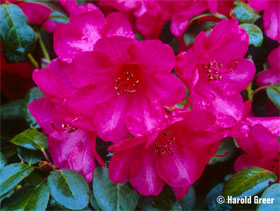 'Whisperingrose'
'Whisperingrose'
|
'Whisperingrose' — (R. williamsianum x 'Elizabeth') 3 ft (.9 m), 0°F (-18°C), EM, 3-4/4. This plant grows in a compact shape, becoming a verdant mound decorated with buds of fuchsia red. The flowers are a solid rose color and appear as wide open bells covering the plant from top to bottom. Leaves are small and round with wine red leaf stems. It is an easy plant to grow, propagates well and buds young. Instead of whispering, you'll want to shout for joy about this one! 1998.
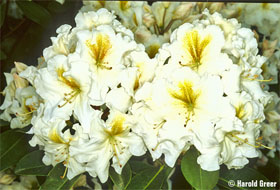 'White Gold'
'White Gold'
|
'White Gold' — ('Mrs. J. G. Millais' x 'Cheyenne') 5 ft (1.5 m), -10°F (-23°C), ML, 4/3. We have a six foot plant of 'White Gold' in our garden that is about 20 years old. Each spring when it blooms from top to bottom with delicious trusses, we realize that this is something special. The flowers are a pure stark white rolled back at the edges as if trying to show every inch of the golden blotch within. The blotch begins as a burning orange deep in the throat, then widens and lightens into rays of golden yellow reaching out onto the upper lobe. Truly beautiful, 1979.
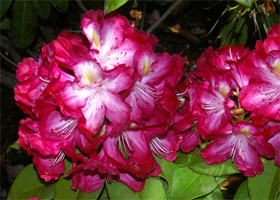 'Wild Affair'
'Wild Affair'
|
'Wild Affair' — ('Jean Marie de Montague' x 'Moser's Maroon') 6 ft (1.8 m), -5°F (-21°C), ML, 4/3-4. Each 'Wild Affair' flower glows! The golden yellow blotch appears to diffuse white light throughout the petal lobes to the rich red petal margins. The foliage is large with an interesting twist, and the color a deep fir green. Plant growth is strong, to complete the excellence of this beautiful plant, 1982.
 'Williams'
'Williams'
|
'Williams' — (unknown) 5 ft (1.5 m), -10°F (-23°C), L, 3-4/3-4. This plant has beautiful pink flowers with a very showy red blotch. The top petal has an interesting 90 degree bend near its tip. This is probably an old English variety whose original name has been lost. It has also been sold as 'Springtime', which is an invalid name, 1976.
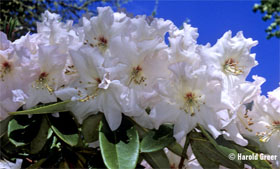 'Winter Snow'
'Winter Snow'
|
'Winter Snow' — ('Kimberly' x R. aberconwayi) 4 ft (1.2 m), -10°F (-23°C), EM, 4/4. Pristine, snow white trusses cover this plant in abundance. Each flower is lightly marked in the center with a small red mark. The flowers form a fairly tight upright truss, which is unusual for a smaller hybrid. Deep green, rounded leaves on a vigorous growing plant that buds heavily is another quality of this wonderful hybrid, 1988.
- 'Yachiyo Red': evergreen az.; unknown, 1987.
- 'Yak-ity-yak': R. degronianum ssp. yakushimanum selection, 1983.
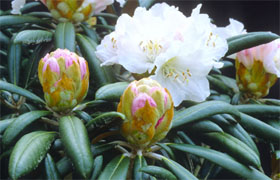 R. degronianum ssp. yakushimanum 'Yaku Angel'
R. degronianum ssp. yakushimanum 'Yaku Angel'
|
R. degronianum ssp. yakushimanum 'Yaku Angel' — 1-4 ft (.3-1.2 m), -25°F (-32°C), EM, 5/5/4. 'Yaku Angel' has longer, narrower convex leaves than most 'yaks'. It buds younger and heavier, and grows easier. In fact, even tiny plants will be covered with buds. When not in flower, it is the most attractive plant in the garden. While it is pink in bud, it opens to the whitest flower of all rhododendrons. This is a must for your 'yak' collection, or, if you have room for only one, this is THE ONE! 1976.
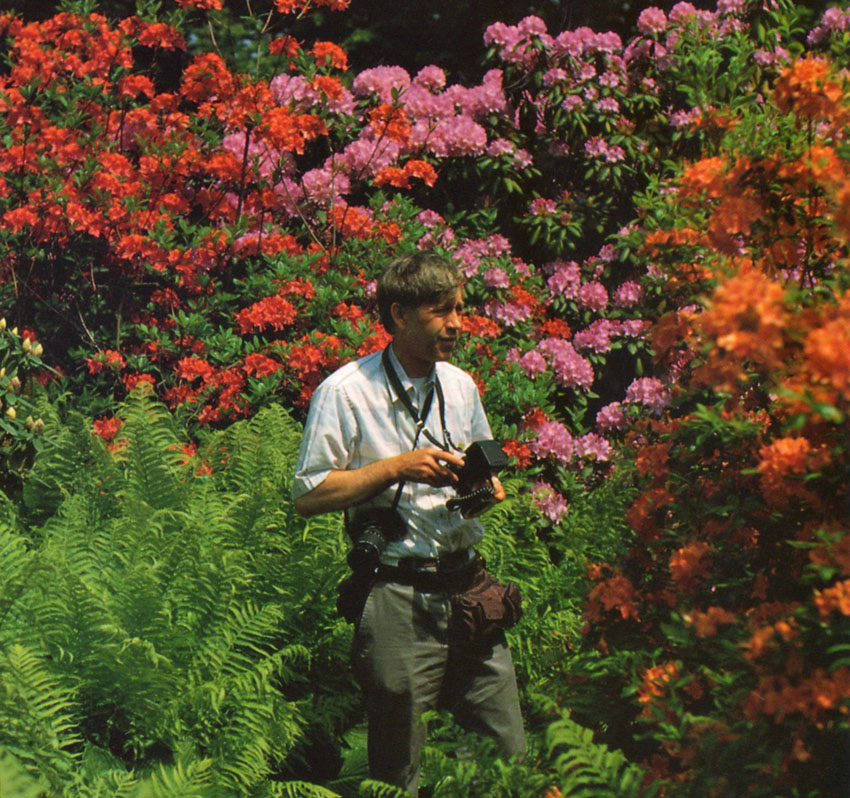
Harold Greer photographing rhododendrons.
Return to Top
Harold's 2020 Christmas Video
Harold made many contributions to the Society including visits to various ARS chapters as a speaker. His knowledge and expertise in hybridizing rhododendrons was unexcelled. Harold also created excellent animated PowerPoint presentations, many of which included a music track. This is Harold's contribution at the December 2020 meeting of the Portland Chapter with a Christmas theme and brief introduction of his new home at the Springs at Greer Gardens, created in the space of his former nursery.
Return to Top
References
- Salley, Homer & Greer, Harold (1986). Rhododendron Hybrids – A Guide To Their Origins. Timber Press.
- Greer, Harold E. (1996). Greer's Guidebook To Available Rhododendrons. Offshoot Publications.
- Nelson, Sonja & Portland Chapter (2001). The Pacific Coast Rhododendron Story. Binfort & Mort.
- The International Rhododendron Register and Checklist Second Edition 2004:
https://www.rhodogroup-rhs.org/publications/books/rhodo-register.
- Greer Gardens to become retirement village; Neighborhood News, December 6, 2012:
https://j361neighborhoodnews.wordpress.com/2012/12/06/4930/.
- Nursery Uprooting; Register Guard, July 9, 2015:
https://www.registerguard.com/article/20150709/news/307099872.
- Greer's Garden at Overleaf Lodge & Spa:
https://www.overleaflodge.com/greers-garden/.
- The Springs at Greer Gardens built on former nursery site; Oregon Live, August 8, 2017:
https://www.oregonlive.com/sponsor-content/?prx_t=PvYCAlEwSATQ4PA&prx_ro=s&ntv_fr.
- Spring Planting for Year Around Color; Register Guard, April 20, 2018:
https://www.facebook.com/registerguard/posts/harold-greer-and-his-wife-nancy-ran-the-formergreer-gardens-nursery-for-50-year/10155338635367256/.
- Harold Greer by Steve McCormick; Niagara Chapter ARS newsletter, September 20, 2019:
http://www.rhodoniagara.org/archives/newsletter/2019-09-20.pdf.
- The Springs at Greer Gardens Photo Gallery:
https://www.thespringsliving.com/seniorliving/or/eugene/goodpasture-island-rd/photo-gallery.
- Anderson Associates, Landscape Planner:
https://www.andersonassociates-la.net/assisted-living-housing.
- Bond Lane Park, Eugene, Oregon:
https://www.eugene-or.gov/Facilities/Facility/Details/38.
- ARS 2022 Spring International Convention Sponsors:
https://ars2022.org/sponsors/.
- Thanks to Don Hyatt for supplying photographs.
- Steve McCormick posted the video Harold made:
https://www.youtube.com/watch?v=cGfWxTUa1D4.
Return to Top
Click Here for printable PDF of this webpage.
American Rhododendron Society
P.O. Box 43, Craryville, NY 12521
Ph: 631-533-0375 E-Mail: member@arsoffice.org
©1998-2021, ARS, All rights reserved.
|

 The Greer nursery on Goodpasture Island Road in Eugene Oregon.
The Greer nursery on Goodpasture Island Road in Eugene Oregon.
 Harold Greer photographing rhododendrons at an ARS convention where he was a speaker.
Harold Greer photographing rhododendrons at an ARS convention where he was a speaker.
 Harold & Nancy Greer at a rhododendron conference.
Harold & Nancy Greer at a rhododendron conference.
 Harold Greer at the 1967 Eugene Chapter Show.
Harold Greer at the 1967 Eugene Chapter Show.
 Harold Greer at Greer Gardens.
Harold Greer at Greer Gardens.
 Harold receiving the ARS Gold Medal in 1989.
Harold receiving the ARS Gold Medal in 1989.
 Greer's Garden at Overleaf Lodge & Spa in Yachats, Oregon - a tribute to Harold Greer.
Greer's Garden at Overleaf Lodge & Spa in Yachats, Oregon - a tribute to Harold Greer.
 Harold Greer at The Springs at Greer Gardens which was built on former Greer Gardens site.
Harold Greer at The Springs at Greer Gardens which was built on former Greer Gardens site.
 The Springs on Goodpasture Island Road in Eugene Oregon..
The Springs on Goodpasture Island Road in Eugene Oregon..
 The Springs at Greer Gardens.
The Springs at Greer Gardens. The Green House at The Springs at Greer Gardens.
The Green House at The Springs at Greer Gardens.
 Tranquil setting among rhododendrons at The Springs at Greer Gardens.
Tranquil setting among rhododendrons at The Springs at Greer Gardens.
 Cottages at The Springs at Greer Gardens.
Cottages at The Springs at Greer Gardens.
 Rhododendrons in the landscape at The Springs at Greer Gardens.
Rhododendrons in the landscape at The Springs at Greer Gardens.
 Rhododendrons in the landscape at The Springs at Greer Gardens.
Rhododendrons in the landscape at The Springs at Greer Gardens.
 Rhododendrons in the landscape at The Springs at Greer Gardens.
Rhododendrons in the landscape at The Springs at Greer Gardens.
 Rhododendrons in the landscape at The Springs at Greer Gardens.
Rhododendrons in the landscape at The Springs at Greer Gardens.
 The landscape at The Springs at Greer Gardens.
The landscape at The Springs at Greer Gardens.
 Bond Lane City Park adjoining The Springs at Greer Gardens.
Bond Lane City Park adjoining The Springs at Greer Gardens.

 Harold Greer's Rcv. 'Very Berry'.
Harold Greer's Rcv. 'Very Berry'.
 'Barto Alpine'
'Barto Alpine'
 'Black Eye'
'Black Eye'
 'Black Magic'
'Black Magic'
 'Blue Lagoon'
'Blue Lagoon'
 'Brilliant'
'Brilliant'
 'Buttermint'
'Buttermint'
 'Everything Nice'
'Everything Nice'
 'Extraordinaire'
'Extraordinaire'
 'Firewine'
'Firewine'
 'Grand Slam'
'Grand Slam'
 'Hallelujah'
'Hallelujah'
 'Heat Wave'
'Heat Wave'
 'Helen'
'Helen'

 'Jackie Ann'
'Jackie Ann'
 'Kimberly'
'Kimberly'
 'Kimbeth'
'Kimbeth'
 'R. kiusianum 'Komo Kulshan''
'R. kiusianum 'Komo Kulshan''
 'Lydia'
'Lydia'

 'Mother Greer'
'Mother Greer'
 'Olin O. Dobbs'
'Olin O. Dobbs'
 'Perfectly Pink'
'Perfectly Pink'
 'Platinum Pearl'
'Platinum Pearl'

 'Red Delicious'
'Red Delicious'
 'Red Eye'
'Red Eye'
 'Senorita Chere'
'Senorita Chere'
 'September Song'
'September Song'
 'Springfield'
'Springfield'
 'Starburst'
'Starburst'
 'Sugar Pink'
'Sugar Pink'
 'Sunspray'
'Sunspray'
 'Trude Webster'
'Trude Webster'
 'Twilight Pink'
'Twilight Pink'

 'Very Berry'
'Very Berry'
 'Whisperingrose'
'Whisperingrose'
 'White Gold'
'White Gold'
 'Wild Affair'
'Wild Affair'
 'Williams'
'Williams'
 'Winter Snow'
'Winter Snow'
 R. degronianum ssp. yakushimanum 'Yaku Angel'
R. degronianum ssp. yakushimanum 'Yaku Angel'
